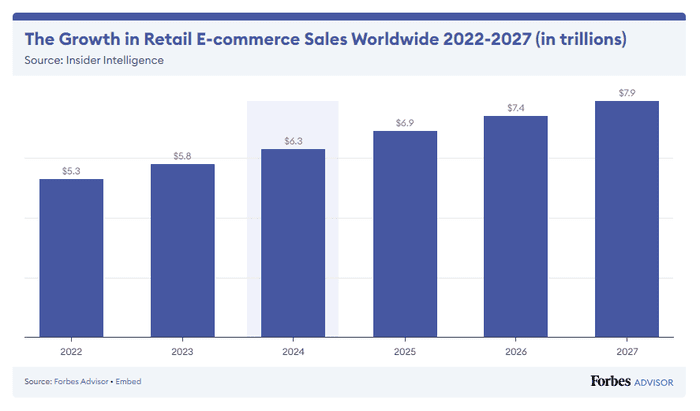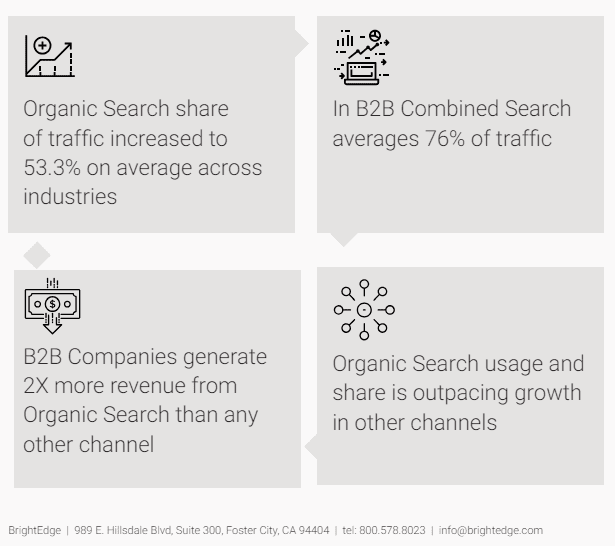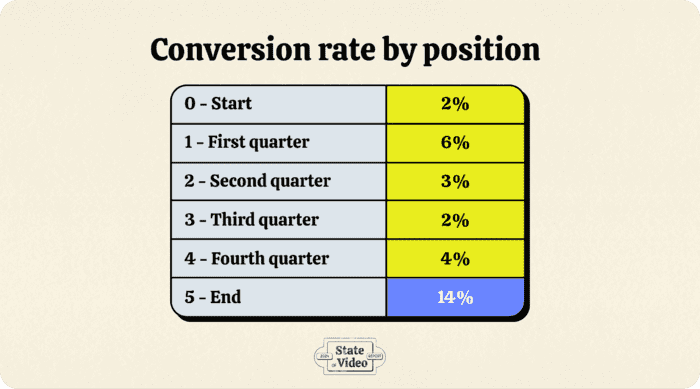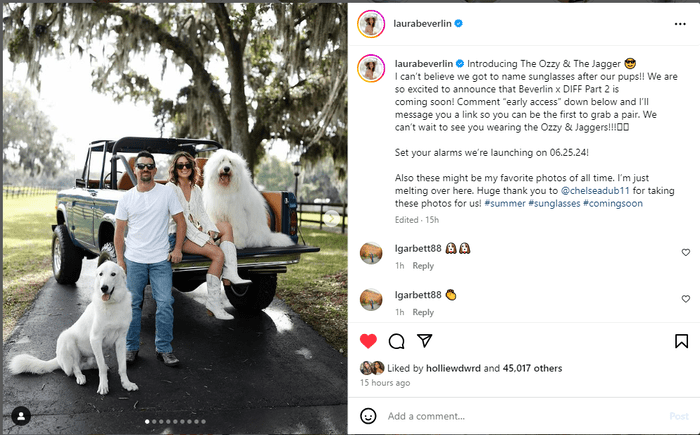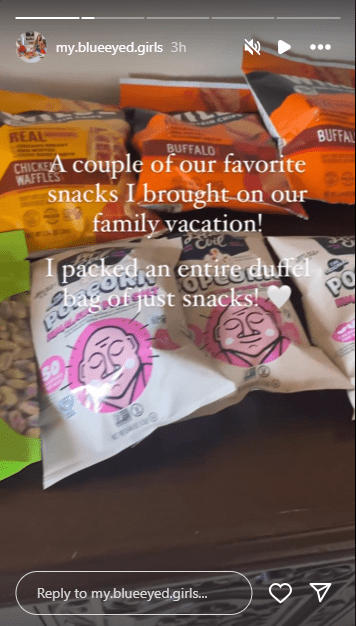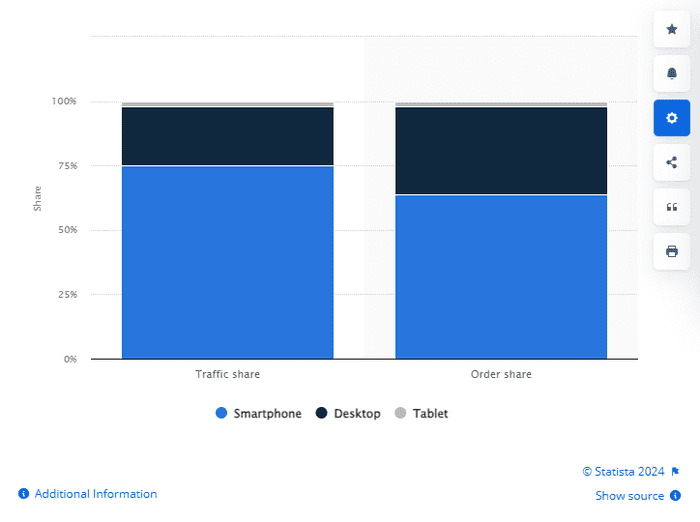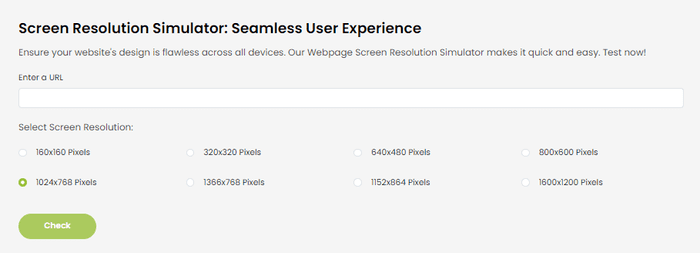3 Advanced Strategies for Content Marketing for E-commerce Websites to Maximize Impact
Imagine your website content as a bright, welcoming store with eye-catching displays and helpful staff.
In e-commerce, your content must drive consumer purchases, making it crucial for your business’s success.
Content is the primary marketing strategy e-commerce brands rely on to move their business forward, and for good reason. Less people are opting to shop in person than ever before.
E-commerce sales growth has continued to trend upward over the years and is expected to grow to $7.9 trillion by the end of 2027. Additionally, by the end of 2027, nearly a quarter (22.6%) of retail purchases are expected to take place in a digital capacity.
The staggering growth seen in the e-commerce industry presents opportunities for digital brands. However, it also breeds fierce competition, where only the business-savvy brands will survive.
To gain a competitive edge, attract high-quality leads, and convert customers, e-commerce brands must develop a strategic content marketing strategy. This extends beyond the traditional blog posts and product descriptions and requires a more nuanced approach—incorporating video, SEO, product reviews, and advanced tools to capture attention.
In this article, we’ll uncover advanced strategies for content marketing on e-commerce sites to maximize impact, improve search visibility, and gain loyal return customers. If you’re looking for where to start your content marketing journey for your e-commerce website, look no further than UNmiss’s free tools for content marketers including a Keyword Generator, Word Counter, and an Article Rewriter.
E-commerce Content Marketing 101
Content marketing is invaluable for digital marketers. It’s proven to be a worthwhile endeavor, with nearly every single marketer (90%) including content in marketing strategies. With almost every marketer seeing the value of content marketing, it’s become a staple in strategies for businesses across every industry.
Content marketing focuses on the creation, management, publishing, and distribution of content related to a product or service. A good content marketing strategy entails creating content for diverse target audiences at every stage of the sales funnel, from awareness to decision.
Unlike podcast or TV advertising, content marketing is more of a soft sell and typically provides potential or returning customers with pertinent information that solves a challenge. It highlights your business as the vendor the customer should engage and purchase with.
Content marketing is beneficial for businesses for numerous reasons including:
- Lead Generation: Three-quarters of companies say content marketing helps grow their lead generation efforts. Businesses that focus on content marketing are better able to engage and retain the attention of consumers looking for the best option to solve their problem.
- SEO: Without content, a website wouldn’t show up close to the top of the search engine results pages. Content is the key force for sharing with crawlers the value of your website and why they should make your website more visible than your competition. Additionally, over half of website visitors arrive from an organic search, further signifying the importance of content marketing.
- Relevancy: When consumers become accustomed to seeing a consistent stream of content from your business, your business stays top-of-mind. It’s important to create a consistent content publishing schedule for blog posts, social media posts, and email marketing to remain relevant with your potential customers.
- Loyalty: Content marketing is meant to deliver relevant and helpful information to the user. The more you show the value of your content, the more likely the consumer will be to come back for more. This helps to grow trust and credibility with your audience, encouraging them to return and convert.
Benefits of Content Marketing for E-commerce Websites
Content marketing for e-commerce websites looks slightly different than for B2B businesses.
For example, content marketers in the B2B world focus on creating content to promote to other businesses rather than customers which brings its own set of challenges such as proving long-term value and ROI (Return on Investment). B2B content also focuses on helping persuade key stakeholders through more detailed or technical content such as a product demonstration video or a case study.
Conversely, e-commerce websites aim to evoke emotions, encourage quick action, and solve low-priority challenges. As such, content can be tailored to be more fun and light-hearted.
Content marketing also comes in the form of social proof or reviews left by other customers who’ve had experience with your business. 88% of consumers say they trust user reviews as much as personal recommendations; highlighting the critical aspect of soliciting and receiving reviews on a consistent basis.
1. Create High-Quality Content for E-commerce
Content creation in the e-commerce realm requires a creative strategy to remain relatable and engaging with your target audience. Stiff, lackluster content won’t resonate with the traditional e-commerce shopper. Instead, they want to be met with content that captures their attention and motivates them to take action.
For example, some of the best hooking words for e-commerce brands to use to attract potential customers include limited time, act fast, exclusive, 20% off, save, and shop now. As you can see these words elicit a sense of urgency and also play on saving money.
In addition to clever hooking words, there are numerous ways to create content and types of content that will engage your content audience.
Blog Posts
For e-commerce brands, blog posts are the cornerstone to content marketing success, when done right. Blog posts should be written to address common customer concerns.
It can be helpful to research questions customers commonly ask when looking for or interacting with your brand. AnswerThePublic is a great free social listening tool that returns relevant results based on questions people are typically asking related to a desired keyword term. This tool can provide valuable insight into what customers want to know and the type of content your e-commerce business should be creating to solve their pain points.
Additionally, it can be helpful to connect with your customer service to mine for common questions they receive.
By creating content that answers frequently asked questions, your customer support agents can direct customers to these articles to provide a solution with comprehensive details, reducing the burden of work for your customer service team.
Ensure your blog posts are written by subject matter experts to ensure they convey expertise and authority in the topic. To set your writer up for success, create a comprehensive content brief that outlines keywords to include, section headers and instructions for each section, ideal content length, number of images to incorporate, and any pertinent information they should include.
Each piece of content should be reviewed by an SEO specialist as well to ensure each piece of blog content is optimized for success. Well-crafted blog posts have a higher probability of ranking in the SERPs.
Videos
In the e-commerce world, videos are no longer nice to have. They are a must have. Consumers want to see how the product looks in real life with a 360-degree, comprehensive view of what they can expect if they were to purchase the product.
Marketers are already jumping on board the product video creation trend with 45% of companies saying they want to create more product videos to showcase their products and expertise.
Videos can be short and simple. The average engagement rate according to recent research shows most consumers prefer videos that are less than a minute in length. Luckily, for e-commerce brands short videos are all it takes to showcase a product.
State of Video in 2024: Video Marketing Statistics & Insights from Wistia
For example, many clothing retailers now include both photos and videos on every clothing item they sell. In some instances, these retailers will include videos of the clothing item on two diverse body types, enabling customers to see exactly how the product will look based on their unique body type.
Giving customers a well-rounded, comprehensive view and a wealth of information can lead to higher conversion rates. Research shows the best place to put a conversion opportunity on a video is the first quarter or final quarter of the video. If you want to have your customers take action, then make sure to enable that action near the beginning or end of your video.
In addition to product videos, other types of videos you may want to include are tutorial videos, behind-the-scenes look at how your business operates, and user-generated videos (which you can find by searching for mentions of your brand on social media).
User-generated videos are an excellent form of social proof and are usually created free of charge. It also shows a user engaging with your product in a meaningful and authentic way that can resonate with your intended audience.
User-Generated Content
Content users create on behalf of your brand is a valuable endorsement for your company and its products. User-generated content (UGC) can come in a variety of formats from writing a blog post, creating a video, leaving a product review, or creating a post on social media.
For paid UGC, brands will typically seek out an influencer within their niche to partner with to promote their products or a specific product. Brands will want to work with an influencer who receives high engagement and who aligns with your business’ core values.
Paid UGC example
For example, a nutrition and supplement brand would want to partner with an influencer who is active in the health and wellness space such as a personal trainer, naturopathic doctor, or nutritionist.
UGC can also arise organically, without payment or solicitation, known as organic UGC. Organic UGC occurs when a real-life customer shares your brand or products without outreach from your business.
A customer may feel compelled to create a video about your product to share with their following helping you further your brand’s reach and recognition. They may also take a picture of your product and share their experience.
UGC also comes in the form of testimonials and reviews. It’s beneficial to share positive testimonials and reviews on your website so visitors can clearly see and assess the benefits of doing business with your brand.
Organic UGC example
2. Optimize Your E-commerce Content for SEO
There are thousands of e-commerce businesses to choose from, which makes it crucial to stand out from your competitors. One way to do so is by crafting a solid SEO strategy to optimize your content for search engines.
SEO helps your e-commerce website be seen by qualified and relevant search traffic. It boosts your visibility in the SERPs, ensuring you’re the top option for a desired keyword term. A well-rounded strategy incorporates keyword research, content optimization, and building a healthy mix of external and internal links.
E-commerce brands must stay on top of evolving SEO best practices to outshine the competition. Keeping up with major Google Core Algorithm updates is one method as well as remaining agile and ready to change at any moment. SEO is a fickle field that requires constant refinement and time investment to ensure long-term growth.
3. Conduct Keyword Research and Content Optimization
Keyword research is the most integral part of content marketing. It sets the stage for whether the content you produce will gain attention or if it will be lost in a sea of similar results.
If your business is targeting a highly searched keyword term that also has a high amount of competition, your chances of ranking for that term will likely be low. Conversely, if you target a long-tail keyword term that is highly searched for but much easier to rank for, your content stands a chance of being seen.
Tools like UNmiss’s Keyword Generator can help you identify ideal keywords to target.
Once you’ve identified the keywords you’d like to target you can add them to your meta tags, landing page content, product descriptions, and more to show Google you’re targeting that specific keyword or phrase.
Keyword research is only the first piece of the SEO puzzle. Next comes optimizing the content to help improve search engine rankings.
Every piece of content you produce should be meant to satisfy your customer’s needs and intent. It’s critical to create helpful content as Google has made it known it will no longer favor unhelpful content that’s written for search engines.
Cheating the algorithm is no longer an option, which means e-commerce marketers must ensure their content is high-quality, well-structured, and detailed. This includes writing detailed product descriptions that give searchers the information they’re looking for such as measurements, product specifications, return policies, and more.
The E-commerce Mobile Opportunity
More consumers are shopping from their smartphones than ever before. In the first quarter of 2024, over three-quarters of retail website visits were made on smartphones in the United States. Additionally, 64% of online shopping purchases were made using a smartphone device.
The opportunity for smartphone purchases is immense, which is why it’s crucial for e-commerce brands to have mobile-friendly websites. Your website should look the same across any device a potential customer uses including smartphones, tablets, and desktop computers.
Consider technical factors that may be impacting your mobile and desktop performance too such as page speed, slow loading times, intrusive ads, and more.
If you’re unsure of how your website is performing, UNmiss offers several free tools to assess performance including a Website Audit tool, Broken Links Finder, and Screen Resolution Simulator.
UNmiss Screen Resolution Simulator Tool
For competitive industries like retail, mastering advanced strategies is a must to build customer loyalty and boost conversions. Content marketing for e-commerce websites looks different than it will in other industries with its own distinctions and best practices.
The foundations of strong content marketing, however, remain essential to maximize success. Traditional efforts such as keyword research, page experience, and content optimization hold equal importance for e-commerce websites.
Content types require a multifaceted approach. Text-based content alone won’t engage e-commerce customers. They want to see and experience the product through well-produced videos. Potential customers will also likely look for social proof before purchasing with your business.
When implementing these strategies, look no further than UNmiss’s abundance of content, on-page, off-page, and digital marketing tools to help your business accomplish its goals. Don’t forget to check out our expansive library of resources designed to educate and inspire organizational success too.



